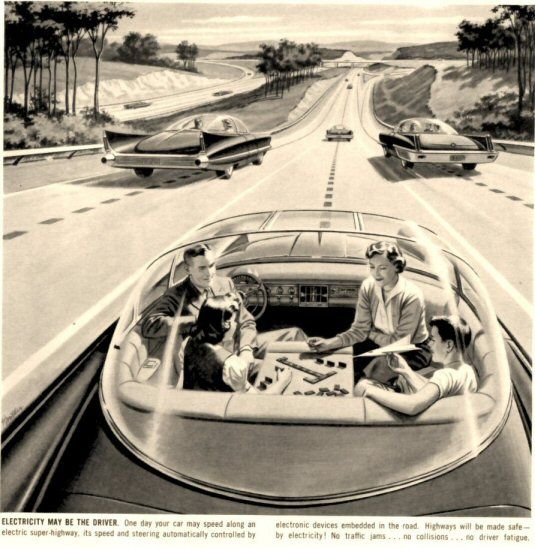Image Source: http://en.believethesign.com/index.php?title=Driverless_Cars
In 1956, an advertisement was run which showed a family playing board games while the car drives itself down a freeway. The wording underneath the picture is “Electricity May be the Driver. One day your car may speed along an electric super-highway, its speed and steering automatically controlled by electronic devices embedded in the road. Highways will be made safe -- by electricity! No traffic jam.. no collisions... no driver fatigue.”
While it might have seemed far-fetched at the time, the research undertaken by a number of companies over the years have now brought some of the basic driverless technology into a range of vehicles now, with features such as automatic breaking and cruise control that keeps a pace with car in front of it.
On their self-driving car project page, Google state that “every year 1.2 million people die worldwide in traffic-related incidents, and over 90% of those accidents are due to human error. Our team hopes to improve people’s lives by developing fully self-driving technology that can improve road safety and make it easier for people to get around.” [1]
Closer to home and looking at an economic impact, congestion costs Sydney $5.1 Billion per year [2] and with road space limited, traffic engineering measures to increase capacity and improve the way road vehicles move around the City are becoming increasingly important.
With its expert team of engineers and impressive research budget, Google has now logged over 1.1 million kilometres of autonomous driving [3]. In its April update, Google detailed information for how it plans to navigate city streets and the complexities involved in replicating how the human brain can process information.
In its latest update, Google has now announced plans to produce its own driverless car [4] with a prototype shown below on the left with a rendered image shown on the right.

Image Source: http://googleblog.blogspot.com.au/2014/05/just-press-go-designing-self-driving.html
The vehicles do not contain pedals or a steering wheel because as stated by Google, “they don’t need them”.
Although many people will find it hard to give up control of driving their car and that situation is still many years away, the possibilities of an all driverless future could put an end to driver mistakes, drunk drivers and the ever pressing need for drivers to check their mobile phone while driving. In addition, during peak hours, cars will be able to very closely follow the car in front which would increase the capacity of the existing road system. The traffic lights would also be able to talk to cars which would allow them to start immediately as the green light shows, further increasing the capacity of the road network.
The technology promises to revolutionise the road network and the way we move around the city. To keep up to date with the project developments you can follow updates on the Google Plus page https://plus.google.com/+GoogleSelfDrivingCars/posts.
[1] https://plus.google.com/+GoogleSelfDrivingCars/posts
[2] Sydney Clearways Strategy, Keeping Sydney Moving, December 2013
[3] http://googleblog.blogspot.com.au/2014/04/the-latest-chapter-for-self-driving-car.html

